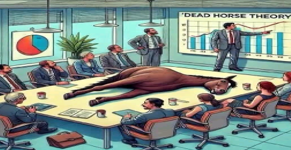By Frank Adu Anim
Parting ways is always difficult, especially when it comes to our cherished and beloved. Coping with the loss of a beloved and moving forward can be immensely painful.
However, it is an inevitable aspect of the mourning journey. “It is said that, the only place to bury a horse is in the heart of his master and that when one is blessed by the companionship and loyalty of a horse, life’s most treasured gift is said to have been bestowed upon you”.
The lessons we could glean from the story of a dead horse is the acknowledgement of the consequence of lack of leadership presence and its significant damage to an organization’s culture, people and the brand.
For the absence of leadership creates a vacuum, people become frustrated, disengaged and employee buy-in is affected.
As a business, what’s the most frustrating dead horse you have been dealing with? How is the situation being handled? It must be acknowledged that most organizations do not reject change out right, instead they slow it down, question it or bury it under excuses.
Why because, change feels risky even when an organization knows it needs to evolve, whether to adopt new technology, restructuring teams, catching up with the world or shifting business models. There is an obvious known invincible forces inside every organization that quietly work against its progress of change.
In part one of the Decision Paralysis series, I did emphasize that indecisive leadership can be frustrating and negatively impactful to a well-functioning team and the overall performance of the organization.
Its impact leads to missed opportunities, reduced productivity, stifled creativity and employee innovation. Oftentimes, the symptoms of organizational inertia coupled with increasing anxiety and unnecessary spending are the unfortunate effects that emanate from indecisiveness.
That said, decision paralysis is something that can affect anyone at any stage of the organizational hierarchy. Overcoming decision paralysis can be challenging, but with time, the process of making decisions within a robust, tried-and-tested framework can help achieve efficiency.
I must emphasize that, decisiveness is not just a trait but a skill that can be honed. Therefore, leaders should view indecision not as a flaw but as an area for growth. By acknowledging the issue, understanding its roots, and actively seeking improvement, any leader can transform their leadership.
Leadership and Decision making
Leading a team or organization requires perseverance, passion and a willingness to adapt. Yet one of the biggest challenges leadership faces ought to do with recognizing when a particular strategy, product or process is no longer working. How the organization’s leadership often continue to pour time, money and resources into efforts that are no longer viable describes a syndrome of dead horse.
It is well known fact that, every leader faces the dead horse syndrome; phenomenon which is a widespread organizational issue and a challenge so persistent and frustrating that, instead of solving it, they do more of the same thing expecting a different result.
Leaders need to make good decisions quickly to help their businesses succeed and stay ahead of the competition. Sometimes, business leaders get stuck in a pattern of overthinking and indecisiveness. They spend all of their time researching and studying the data, never feeling confident about the next step.
Improving leadership decision making will require a commitment to certain key practices, creating an environment where leaders can listen, learn and adapt. By so doing, leaders can foster and more effectively demonstrate the will and passion to succeed.
The Hidden forces that Block Change:
Change is not just a strategy but a leadership skill. The lack of it is not the lack of ideas but refusal to let go of what is comfortable. Resistance to change is not about loud protest or direct opposition instead, an indirect, quiet, slow and convincing approaches that affects decision to take too long a time than they should.
When leaders nod in agreement but never act and when old ways get defended with the statement…this is how we have always done it, they are clear signs.
It is mentioned that speed kills competitors but bureaucracy kills the organization. When the most talented employees become frustrated and leave because they cannot executes ideas, when the company keeps talking about transformation but never actually transforms, when past success blinds leaders to what’s coming next and longevity is mistaken for effectiveness, effort to lead change is negatively impacted.
When People Fear Losing Control
When People fear losing control, they slow down change. When leaders build careers on a certain way of working, they do not resist change, they resist feeling powerless.
Typically, we can mention Leaders who insist on reviewing everything even decisions they previously delegated. When teams withhold key information and keep control over knowledge as a form of power, when every decision suddenly needs extra validations with endless alignment discussions, delaying action under disguise of being thorough, change effort is curtailed.
The Theory of the Dead Horse
This theory comes from the business world. Although it seems like an absurd caricature, it portrays the behavior of many organizational groups.
It shows the attachment to senseless ideas, the blindness to the obvious, the stubbornness in asking for the impossible and the inertia in proposing unviable objectives.
The repetition of ineffective remedies is a common problem in many organizations reluctant to get rid of sterile or non-functional ideas and projects.
A horse is the projection of people’s dreams about themselves, strong, powerful, and beautiful and it has the capability of giving us escape from our mundane existence. For a business, addressing the dead horse theory is essential to maintaining agility and long term sustainability.
This organizational anomaly is due to several possible reasons. Sometimes, because it is the idea of someone who is given great authority and no one dares to confront him, it may also happen that there are too many commitments made previously we insist on making it work no matter what.
The question is, what best strategy could be deployed as an organization when you discover that you are riding a dead horse? Certainly, this requires the willingness to embrace change and prioritize innovation and creativity.
Why Do Leaders Ride Dead Horses?
Despite the obvious harm, organizations continue doubling down on failing strategies. Why? Because, humans are wired to resist change and avoid discomfort. Here are the common psychological and organizational traps that keep leaders on dead horses
Sunk Cost Fallacy:
The reason that we have already invested too much to stop now compels leaders to get emotionally attached to projects, strategies or processes because of the time, money and efforts already spent. However, it is prudent not to allow past investments to dictate future decisions
Fear of Admitting Failure:
Though great leaders understand that vulnerability builds trust, no one wants to admit they were wrong when they are left vulnerable. Egos and reputations are often at stake and admitting failure can feel like a personal or professional loss and avoiding it only deepens reputational damages.
Over-Reliance on Activity as Progress
The notion that if we are doing something, we are making progress. Busyness is often mistaken for productivity. Adding meetings, people, and tools give the illusion of progress but activity without results is just noise.
How do we avoid the Dead Horse Syndrome?
We have always done it this way is a shortcut to obsolescence. Hence, it is important for organizations to be willing to make changes and try new strategies. For all leaders to have an in-depth understanding of why a strategy works or not, this can involve taking a step back and re-evaluate the organization’s mission and goals as well as engaging in regular evaluations to ensure that programs and strategies are still meeting the needs that they were created for.
It is also important for leaders to be open to feedback from employees and key members and to use this feedback to make improvements and change to their programs and strategies.
Another way to avoid the dead horse is to prioritize innovation and creativity within the organization. This can involve encouraging staff members to think outside the box and to come up with new and innovative ideas for programs and strategies and adopt a regular approaches to challenge the status quo.
The Dangers in Riding Dead Horses:
It’s easy to dismiss this concept as a metaphor. However the consequences are far from hypothetical. Riding a dead horse has serious implications for businesses and organizations. What are the dangers?
It Wastes Resources on the Wrong things
When leaders refuse to address the root cause of an issue, they end up throwing money, people and technology at it. It looks productive but it does not fix the underlying problem. For instance, when an organization struggles with sales and blames the marketing team instead of diagnosing their poor product-market fit, they double the marketing budget. The result obviously is twice the spend but same poor outcomes
It Creates a Culture of Avoidance:
When employees see leaders avoiding tough decisions, it sets the tone for the entire organization. People begin to follow suit, sweeping issues under the carpet or sticking to the status quo because “That’s how we have always done it”. A company experiencing bottlenecks in its supply chain avoids tough conversations with its underperforming vendor. Instead, it adds more inventory and builds buffer time into its processes. Employees see the inefficiency but stay silent, knowing leadership is not willing to confront the vendor relationship.
It kills Employee Engagement:
Nothing demotivates high-performing teams faster than seeing their time wasted on futile efforts. When employees realize that their input does not matter or that leadership lacks the courage to tackle real issues, morale dwindles. Imagine being asked to sit through weekly alignment meetings for a project that is clearly failing? Over time, even your best people will check out, lose faith or leave the organization.
It Gives Competitors the Advantage:
While you are busy pretending the horse is not dead, your competitors are moving forward innovating, streamlining and gaining market share. In today’s hyper-competitive landscape there’s no room for dead weight. Think of companies like Nokia which clung to its failing phone models, Samsung kept redefining the entire Phone industry. Whiles Nokia kept riding its dead horse straight into irrelevance, Samsung continued to be creative, innovative and relevant in the market.
Managing the Cycle of Dead Horse Riding:
Most often, when leaders are faced with dead horse challenge they buy a stronger whip and threaten the horse with termination.
Sometimes, they change riders, appoint a committee to study the horse, hire outside contractors to ride the dead horse, harness several dead horses together to increase the speed, provide additional funding and or training to increase the dead horse’s performance, do a productivity study to see if lighter riders would improve the dead horse’s performance, declare that as the dead horse does not have to be fed, it is less costly carry lower overhead, and therefore contributes substantially more to the bottom line of the organization than do some other horses, rewrite the expected performance requirements for all horses and or promote the dead horse to a supervisory position of hiring another dead horse.
Leaders who refuse to ride dead horses approach problems differently. They focus on addressing the root cause because fostering transparency and making bold decisions even when it’s uncomfortable is considered appropriate. Here is how:
Make a Decision by Asking the Right Questions
Great leaders challenge their teams and themselves with questions like: what is the real issues we are trying to solve, why do we keep doing this, if we were starting afresh today would we still make this decision? It is encouraging that leaders make decisions based on future potential not past investments. If a strategy no longer aligns with long tern goals, it ought to be abandoned without hesitation.
Encourage Radical Transparency when Making Decisions
Build a culture where people feel safe pointing out inefficiencies or challenging the status quo. When employees are empowered to say “This horse is dead, it saves everyone time and effort. The culture of encouraging candor and debate enable the team to address issues head-on rather than hiding them.
Focus on Decision Outcomes, Not Activities
Instead of tracking the number of new features launched, focus instead on customer satisfaction or retention rates as your true measure of success. Here, measurement of success by results not busyness is critical. Replacing vanity metrics like hours worked or meetings attended with meaningful KPIs that align with the company’s mission is significantly important.
Know when to Cut Your Losses
Sometimes, the bravest decision is to stop. Whether it’s shutting down a failing product, ending a toxic vendor relationship or cancelling an ineffective strategy, dismounting is the only way to move forward.
Decisiveness sets apart the most effective leaders. And that, high-performing leaders distinguish themselves not by infallibility but by their swift and confident decision-making. They act promptly and firmly, even in ambiguity and with partial information. Again, decisive leaders are more likely to be high-performing, embodying the principle that a swift decision, even if imperfect, often outweighs the cost of inaction.
Re-classifying the dead horse as living impaired
If the leader is faced with a range of possibilities, he or she ought to start by having a quick thought about the desired outcomes and the potential choices. It is important to discard any issue that are not a great fit, leaving the leader with a shortlist of options. This shortlist will be much less daunting and is likely to induce anxiety.
In summary, let me conclude by admitting that, one cannot train a horse with shouts and expect it to obey a whisper, therefore leaders must outline decision making frameworks to provide everyone with parameters to work within, preventing the feeling of anxiety and the overwhelming factors that lead to decision paralysis.
Discovery….Thinking solutions, shaping visions.
Frank is the CEO and Lead Consultant for Discovery Leadership Consulting Ltd and a Harvard Business Review Advisory Council Member.
Email: [email protected]










